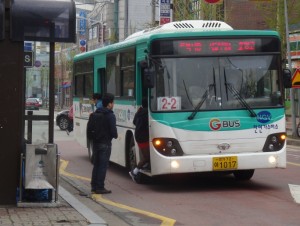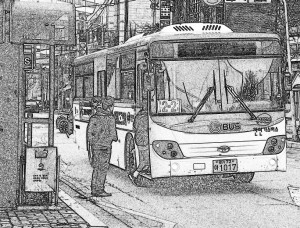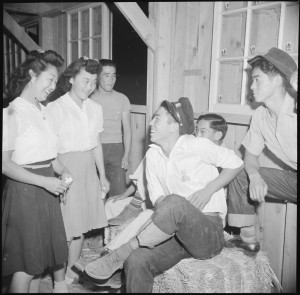1. Where is this picture taken?
This picture is taken at a bus stop.
2. What are the people in the picture doing?
Two of the people in the picture are getting on the bus. One person is getting off the bus.
3. Is this a city bus, or a long-distance bus?
This is a city bus.
4. Where might the people be going?
The people might be going to work or school.
5. What is the first thing you have to do when you get on the bus?
When you get on the bus, the first thing that you have to do is pay the fare.
6. What are the different ways that the fare can be paid?
The fare can be paid with cash. In many buses, you can also pay by swiping a card that has credit available on it. Another option is to buy a pass, especially if you use the bus every day.
7. If you pay with cash, can you get change back if you have big bills?
Some buses can give you change back if you pay with big bills. Other buses will accept only exact change for cash fares. This means that they are unable to give you change back if you use bills that are bigger than the fare.
8. What is a bus pass?
A bus pass is special ticket that allows you unlimited rides within a certain time frame, like a monthly pass, a weekly pass, etc.
9. What kind of discounts are available for bus fares?
Many bus companies have various discounts available: student discounts, senior citizen discounts, or handicapped discounts. If you don’t get a discount, you have to pay full fare.
10. Where can you sit on the bus?
On the bus you can sit in a seat. The seat may be in the front of the bus, at the back of the bus, or in the middle.
11. What can you do if there are no more seats on the bus?
If there are no more seats on the bus, you will have to stand. Holding on to a strap will make it easier for you to ride the bus standing.
12. What can you do if you have to take a bike on the bus?
If you have to take a bike on the bus, some buses will let you put the bus in the back by the rear door. Other buses have a bike rack (on the front of the bus, for example) where you can put the bike.
13. What can you do if you have to take a baby stroller or baby carriage on the bus?
If you have to take a baby stroller or baby carriage on the bus, you can take it on board at the rear door, where there is more space.
14. How can you tell which bus you should get on?
You can tell which bus you should get on by reading the route sign at the front of the bus.
15. How can you tell when your bus is coming?
You can tell when your bus is coming by reading the bus schedule.
16. What happens if you are late for your bus?
If you are late, you will have to run to catch the bus. Otherwise, you will miss your bus.
17. How can you notify the driver that you want to get off at the next stop?
If you want to get off at the next stop, you can let the bus driver know by pulling the communication cord. This notifies the bus driver that someone wants to get off at the next stop.
18. What kind of routes do city buses have?
City buses have routes that go all over the city. They stop at many different places.
19. What kind of routes do long-distance buses have?
Long-distance buses have buses that travel from city to city. They usually do not stop at many different places within a city, but they might make several stops along the route between cities.
20. How is a long-distance bus different from a city bus?
City buses are plainer than long-distance buses. They have seats that are more utilitarian, and their overhead shelves hold more, but they don’t have a separate space for storing luggage. They also have a front door and a rear door. Long-distance buses are usually coach buses, so they are more comfortable, with nicer seats, curtains, individual air controls and lights, and a luggage area under the bus. Coach buses have only a front door, and not a rear door.
Paragraph: Going for a bus ride
One time I had to travel from one city to another. The two cities were about 575 km apart, but I did not have a car. So I had to take the train part of the way (about 450 km), and a bus the rest of the way (about 125 km). After I got off the train, I walked over to the bus and had the driver put my luggage in the storage compartment under the bus. I gave the driver my ticket, and got on board the bus. There were no assigned seats, so I could pick whatever seat I wanted. I found a seat in the middle of the bus, and sat down by the window. I was traveling for Christmas vacation, so I also had some Christmas presents in a carry-on bag, which I did not want to put in the luggage compartment. I put the Christmas presents on the seat next to me. The seats were comfortable. They had a foot rest, and they could recline, so I was set for the long bus ride. We traveled down narrow country roads that wound along farms and fjords, and hugged mountains. Halfway through the bus ride I had to transfer to another bus to get to my destination. Even though the bus was comfortable, it was nice to get up and stretch my legs before continuing on the final leg of my journey. At long last, the bus pulled into the terminal, bringing me home for the holidays.








